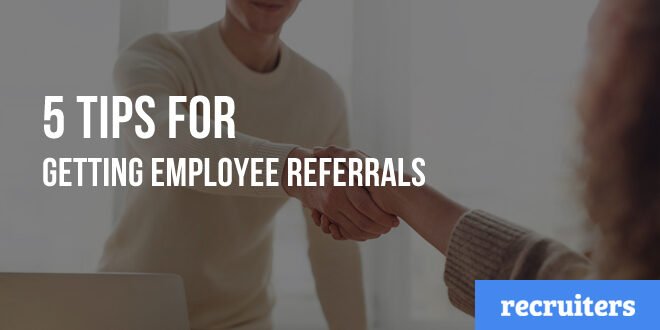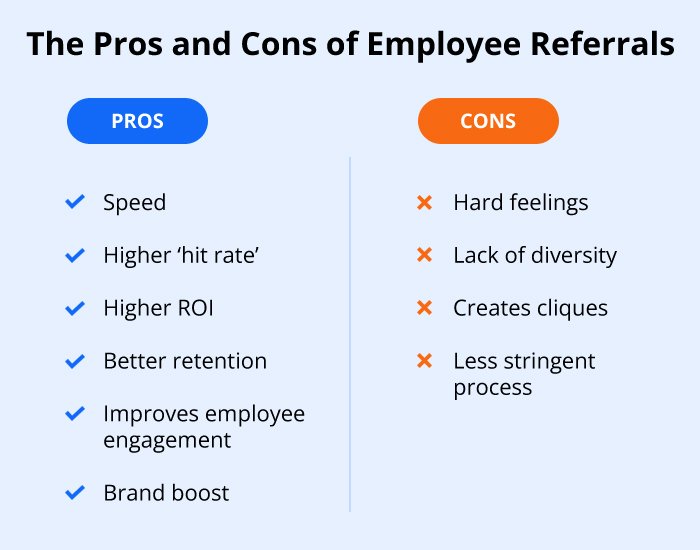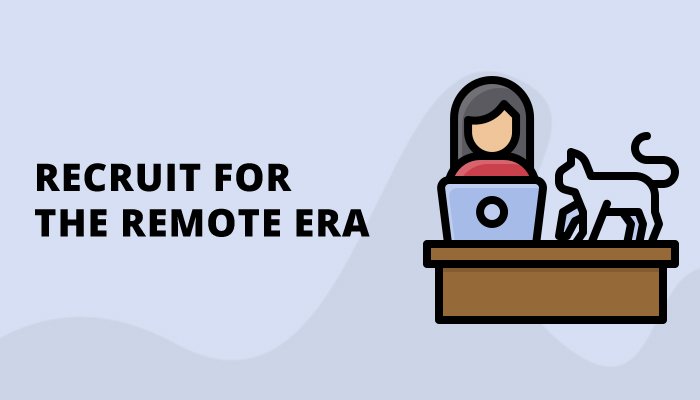5 Tips for Getting Employee Referrals

If you’re in recruiting mode, then you know just how important it is to have the right talent in front of you.
And in a competitive marketplace like this, where talented professionals usually have multiple options to choose from, it’s always helpful to have multiple sources for talent. This includes employee referrals.
The Pros and Cons of Employee Referrals

As with anything, there are benefits and downsides to using employee referrals to fill your talent pipeline with candidates. Let’s start by exploring the advantages:
- Speed. Employee referrals help you quickly connect with talented candidates. It speeds up the process by putting you in direct contact with people who may be qualified for the job. This can save you weeks (or even months) and allow you to fill critical openings much sooner.
- Higher ‘hit rate’. Job applicants tend to have a much higher conversion rate when they’re referred by an existing employee (as much as 6 percent higher). This has to do with the fact that they enter the process with an intuitive sense of trust in the company and an appreciation for the culture (because of their connection with the referring employee within the organization).
- Higher ROI. According to one study, employers spend an average of $4,129 to fill an open position. Not only that, but it takes 42 days to make a hire. As the duration of the search, job role, and salary increase, so does the cost. Considering it doesn’t cost very much to pay an employee a referral bonus, you get a much higher return on your investment with referrals.
- Better retention. On top of all of these benefits, employee referrals tend to stay with the firm longer, are usually better cultural fits for the organization, and start with a very positive first impression of the company. This healthier retention rate breeds its own set of advantages over the years.
- Improves employee engagement. Employees like to know that they’re being listened to and cared for. And what better way to show an employee you care than by asking them who they would recommend for a job opening? The act of gathering referrals alone is enough to strengthen your employer-employee relationships. But if you happen to hire a referred employee, the experience is even more positive. The employee gets the positive feeling of knowing they’ve helped both a friend and the company.
- Brand boost. Your employees are basically advocates for your brand. When you ask them to bring you referrals, you’re basically sending them out into the marketplace and asking them to speak positively about your brand within their social group and circle of influence. This elevates your brand’s image and puts you in front of people who otherwise might not have known you existed (or had never seen this side of your business).
Having said all of this, it’s usually not recommended to fill all of your positions with employee referrals. Here are some of the reasons why:
- Hard feelings. Some employees will develop hard feelings toward the organization or certain hiring managers if their referrals aren’t interviewed or chosen for the job. While you obviously can’t hire every single candidate that comes across your desk, you’ll have some explaining to do when you don’t hire ‘Cathy From Accounting’s’ best friend.
- Lack of diversity. If one of your goals is to create a more diverse workforce with people of different backgrounds and personalities, an employee referral program usually doesn’t help much in this area. Why? Because, by and large, people tend to hang out with other people who are like them. Too many referrals will simply multiply what you already have. (This could be a good thing, but don’t expect to get much diversity out of it.)
- Creates cliques. If you hire several employees via referrals, you run the risk of creating cliques within your team. Your new employees may only hang out with the people they already know, while your other employees might stick to themselves. This can have a negative impact on the culture as a whole.
- Less stringent process. If you aren’t careful, you can begin to rely too much on the opinions of your employees. And while they might bring you some good talent, you have to remember that they’re biased. Don’t lose your objectivity – continue to be thorough.
Try These Employee Referral Tips
As you can see, there are pros and cons to hiring with employee referrals. Ultimately, your success here comes down to how well you’re able to manage the process. Curious about how to get the best employee referrals for your job openings? Here are several tips:
1. Create an Employee Referral Program
The best way to generate a consistent stream of employee referrals is by creating a formal employee referral program. This program allows you to create rules, standardize processes, and set up rewards for employees who refer new hires.
When creating an employee referral program, pay careful attention to how you want it to be structured. Proactively ask questions like:
- How often do we need to make new hires?
- Which positions need to be filled most frequently?
- What are our minimum requirements for new hires?
- How do we describe our company culture?
- Which types of candidates are the best fit for our company culture?
- How much can we reasonably afford to incentivize employees for referrals?
As you answer these questions, the basic sketch of your program will start to take shape. Based on this, take the time to create clearly defined rules and processes that help you achieve your recruitment goals.
Pay especially close attention to how employees recommend applicants, what sort of hand-off process takes place from referral to interview to hiring, etc. You’ll likely need a person in charge of the employee referral program to ensure consistency and address any issues or complications that arise.
It’s equally important that you make current employees aware of the types of people you’re not looking for. This should usually be handled on a position-by-position basis. In other words, if you’re looking to add a new senior management or executive position, be very clear about who you are and are not looking for (regarding work experience, seniority, etc.). Otherwise, you may end up with inexperienced candidates who are much better suited for lower level management positions. Being clear on the front end will save you lots of time (and prevent hard feelings).
2. Advertise the Incentives

Incentives are what make an employee referral program work. Without proper incentives and rewards, your employees have very little reason to recommend someone. The key is to identify the right incentives and to then advertise them in a way that your employees feel compelled to act.
According to research, 74 percent of employers offer referral incentives. Out of these companies, 92 percent offer cash rewards. The median award is $1,000, while $500 rewards are the most common.
In addition to the size of the monetary reward, you also have to think about the structure. Many companies pay out rewards incrementally based on how long the new hire is with the company. For example, 50 percent of the reward is paid out immediately, while the other 50 percent is paid out if the employee stays for six months.
While we often assume that monetary incentives are best, this isn’t always the case. Yes, money does talk, but there are other powerful motivating forces. Recognition is one of them. Sometimes employees just want to be recognized for their contributions. If you layer recognition on top of the monetary reward, you make your employees feel appreciated and cared for. This fosters even healthier connections.
3. Give Employees What They Need
Any company can create a plan for incentivizing employees. However, if you want your employees to actually bring you qualified candidates in an orderly manner, there has to be some clear structure. Give your employees what they need to be successful.
Left to their own devices, employees will refer an employee however they want and whenever they want. (They’ll also say whatever they want.) But as you know, details matter in recruiting. Employees should be given scripts and templates they can use to reach out to candidates within their network. If you want them to send all applicants to a specific URL to fill out forms, give them this URL. Supply them with everything they need to get the process rolling. Not only does this bring clarity to the referral process, but it also cuts down on unnecessary back-and-forth between you and the employees doing the referring.
4. Keep Lines of Communication Open
Poor communication and a lack of transparency are among the most frustrating things for an employee participating in a referral program. While you don’t owe an employee anything in terms of explaining your hiring decisions, you should keep open lines of communication in regards to how the process is going, what stage of hiring you’re in, etc.
To avoid frustration from all sides, it’s a good rule of thumb to respond to every single candidate referral within seven to 10 days (whether you choose to interview them or not). And once the process begins, be sure to keep the referring employee abreast of any major developments. (For example, notify them when an interview has been scheduled/conducted.)
Not every referred candidate will be hired. But if you keep the lines of communication open, at least the referring employee will know that you’re taking their referrals seriously.
5. Track Data and Feedback
Take time to measure your referral program and track the data. You should also gather feedback from employees, applicants, and new hires to see what the experience is like and where things can be improved. You’ll want to track things like:
- The running total of employees hired through referrals
- The retention rate of employees hired through referrals
- The performance of employees hired through referrals
- The number of new hires referred by each employee
As you track this information, compare it to the data you have on file for other methods of hiring (i.e. job boards, recruiting agencies, etc.). This will give you a feel for how successful the program is.
Every quarter, we recommend reaching out to your employees to see how they feel about the program. Speak with the ones who have successfully referred employees, as well as those who haven’t yet participated. This will give you a feel for how employees on both ends of the spectrum feel toward the program.
Recruit for the Remote Era

At Recruiters.co, we understand that recruiting and staffing agency services in the remote era doesn’t always look identical.
When compared to traditional recruiting, there are some nuances that must be accounted for. Our unique and proven approach to staffing ensures you get access to the right talent for the right positions. Contact us today to learn more!
- Mastering Internal Mobility: A Comprehensive Guide to Success - August 10, 2023
- Effective Recruiting Strategies in a Competitive Sales Labor Market - July 27, 2023
- 6 Essential Factors to Attract Top Talent - July 19, 2023
